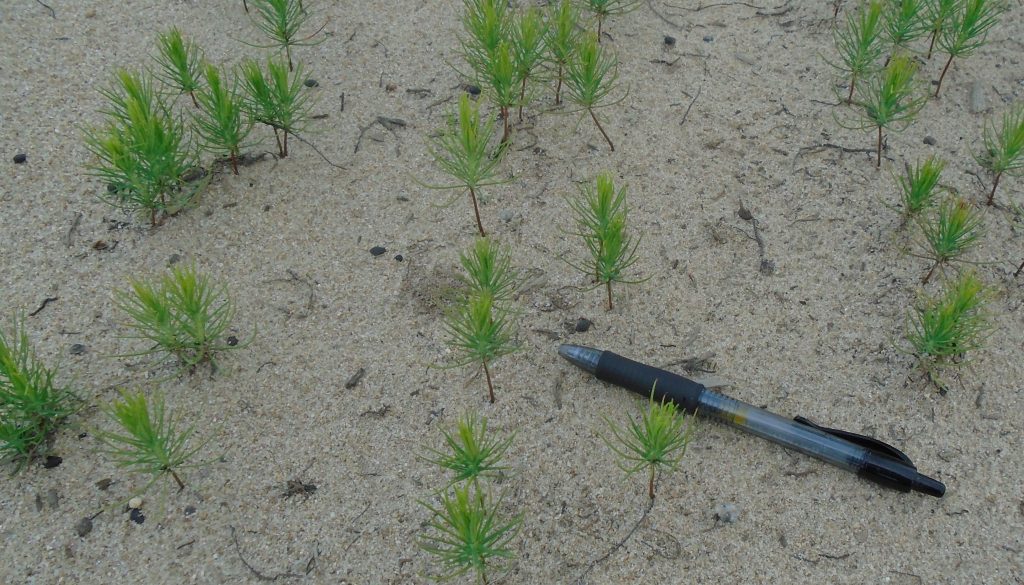
Garland Gray Forestry Center will ship 30 million loblolly seedlings for planting next spring. The weather has been favorable for the seedlings and there will be more than ever, but demand still will exceed supply. These trees have been developed for the specifics of Virginia climate and conditions.

Loblolly pines grow naturally from Florida to New Jersey, but the trees that grow well in Florida are not ideal for colder Virginia. Virginia’s weather is unreliable during the spring planting season. The trees from Garland Gray go completely dormant during the winter, so that will not as easily perish if there is a cold snap or prolonged dry spell. This cost a little in terms of growth. A Florida loblolly pine will be quicker out of the start, great if the weather is warm and moist, deadly if not. A Virginia loblolly seedling may turn reddish brown if it gets cold before its roots are established, but it will usually come back.
We are past the third generation of loblolly pine in Virginia. In the first generation, they just gathered cones. The idea was simple reforestation and the ordinary native true was okay. But they improved, taking the seeds from the strongest, straightest and fastest growing.

The newest generation of loblolly is as different from the first as a Chihuahua is from a German shepherd. They are the same species but you wouldn’t know to look at them, even after only a few years. The natural loblolly is a bit of a weedy tree. It tends to grow crooked and branches. It is also susceptible to various maladies. The newer versions just genetically superior. They grow better on the same sites with less fertilizer.
The loblolly became the premier tree of the American South for good reasons. These reasons were man-made as much as natural. As mentioned above, the varieties developed are much better than the natural tree. On the “natural” side, the loblolly is relatively easy to manipulate genetically. It breeds true to its parents’ characteristics. (A contrary example is an apple. Apples do not breed true and the apple you plant from a side will not closely resemble its parents. For that reason, almost all the apples we eat come from clones.) The loblolly also responds especially well to fertilization and release, i.e. if you cut the trees around a loblolly it will grow more rapidly. Most other species do not respond as well.
This is not all to the good. Loblolly has replaced other timber trees in wide areas. The more worrying trend, IMO, relates to the length of rotations. This has more to do with prices than with the trees themselves, but the rapid development of loblolly may facilitate it. Let me explain.
The standard loblolly rotation used to be about thirty-five years in Virginia. This meant that you thinned the trees twice, at about fifteen years and again at twenty-four, and then harvested saw timber at the end. This is not a very long rotation, but it does provide a relatively mature forest. When combined with stream management zones, largely left perpetually uncut, you provided a productive wildlife habitat and good protection for soil and water.
New developments permit the use of smaller diameter wood. The prices of saw timber, i.e. bigger logs, and the smaller pulp timber have been converging. You do not get that much more money from saw timber. This means that the payoff from growing trees longer is less but the risks have not diminished. There is also the time value of money. Waiting an additional fifteen or twenty years for the payoff from your forestry requires patience and maybe you will be dead before you get the benefit of your investment. Some experts are advising that we harvest trees on shorter rotation, maybe as little as twelve years. The trees never mature and we never have a true forest. We just maximize fiber production. It is more like a field crop. I don’t like this even a little. While I can see the profit possibilities, I did not get into forestry for this. But I digress.
The loblolly seedlings have also improved over the years. You can see from the pictures that the soil at Garland Gray Forestry Center is very sandy. This make cultivation much easier. They have a machine that trims the roots underground, both horizontally and vertically. The roots are trimmed to about five inches long. This is because most of the tools used to plant trees dig down about seven inches. This makes planting more effective and prevents the development of “J-roots”. They also trim the tops so that seedlings are uniform height. In the old days, they would need to plant more than 700 trees per acre because many were expected to die. Today, they plant only around 450 because almost all of them survive. Loblolly pines need to planted deep, even below the root collar. This is a contrast to longleaf that need to be planted shallow. All the loblolly pines produced at Garland Gray are bare root. All longleaf for Virginia are grown in North Carolina and they are containerized.
Only five people work at Garland Gray. Most of the work is done by machines. They are precise. It is very important that the rows be straight, so that the fertilizer can be applied and so that the machines that lift the seedlings can be used properly.
My pictures show the little pine trees. They have a machine that plants them. It works kind of like a paint brush. You can see the size in relation to my pen. They remind me of those little trees that they use in model train sets. Picture #3 shows the sign for the Garland Gray Center. The last picture shows a longleaf plantation. They represent trees from various states to show which grow the best in Virginia.
